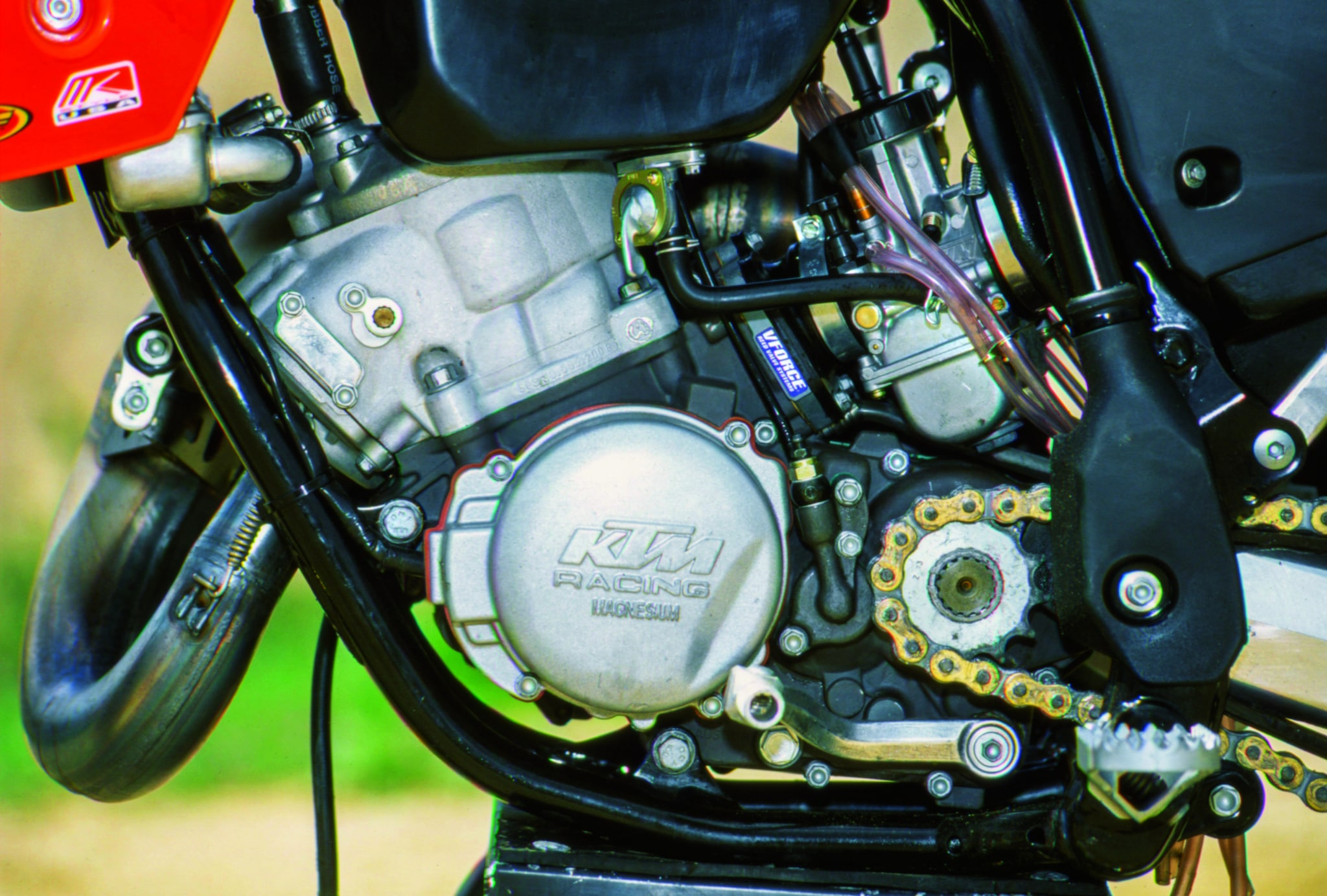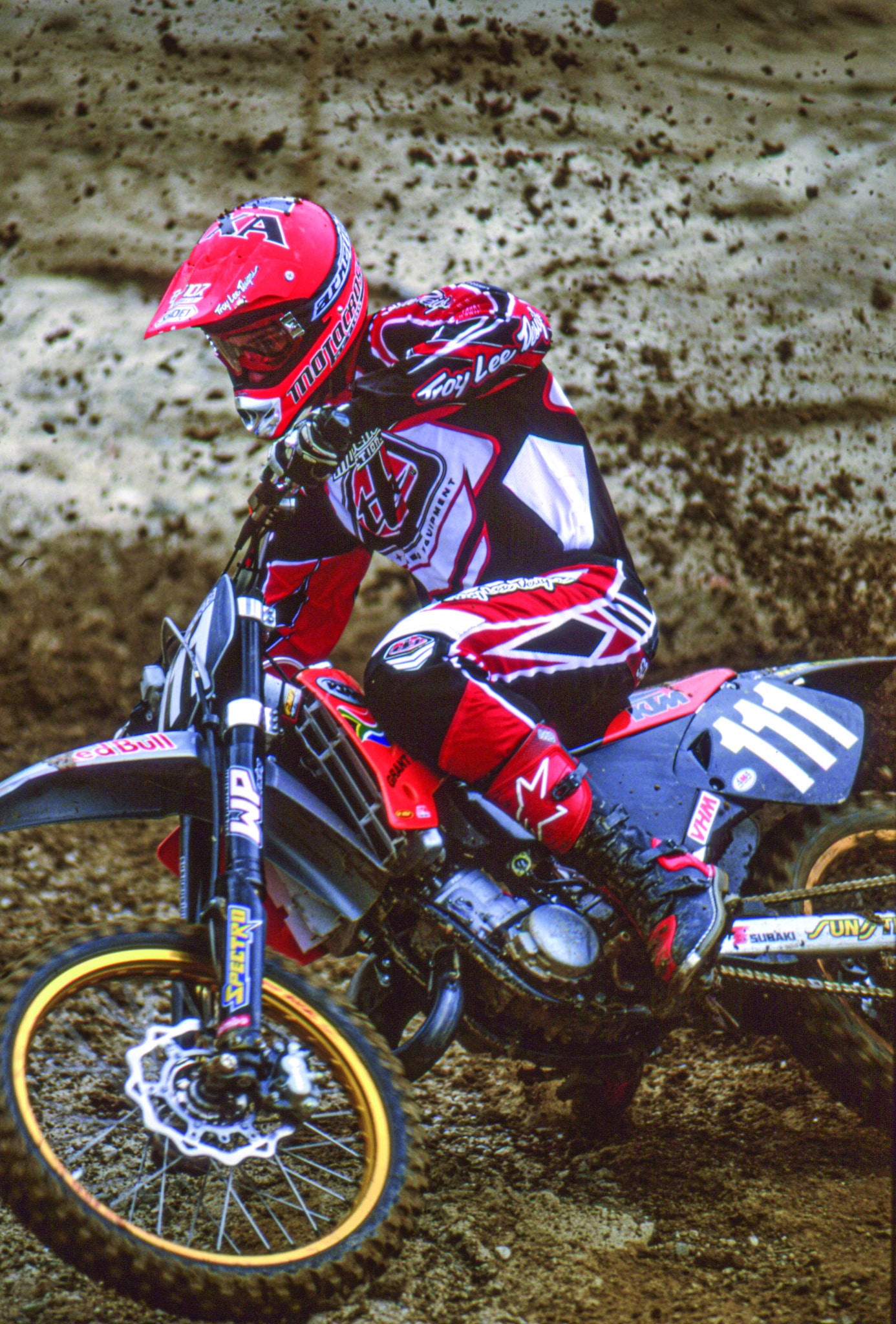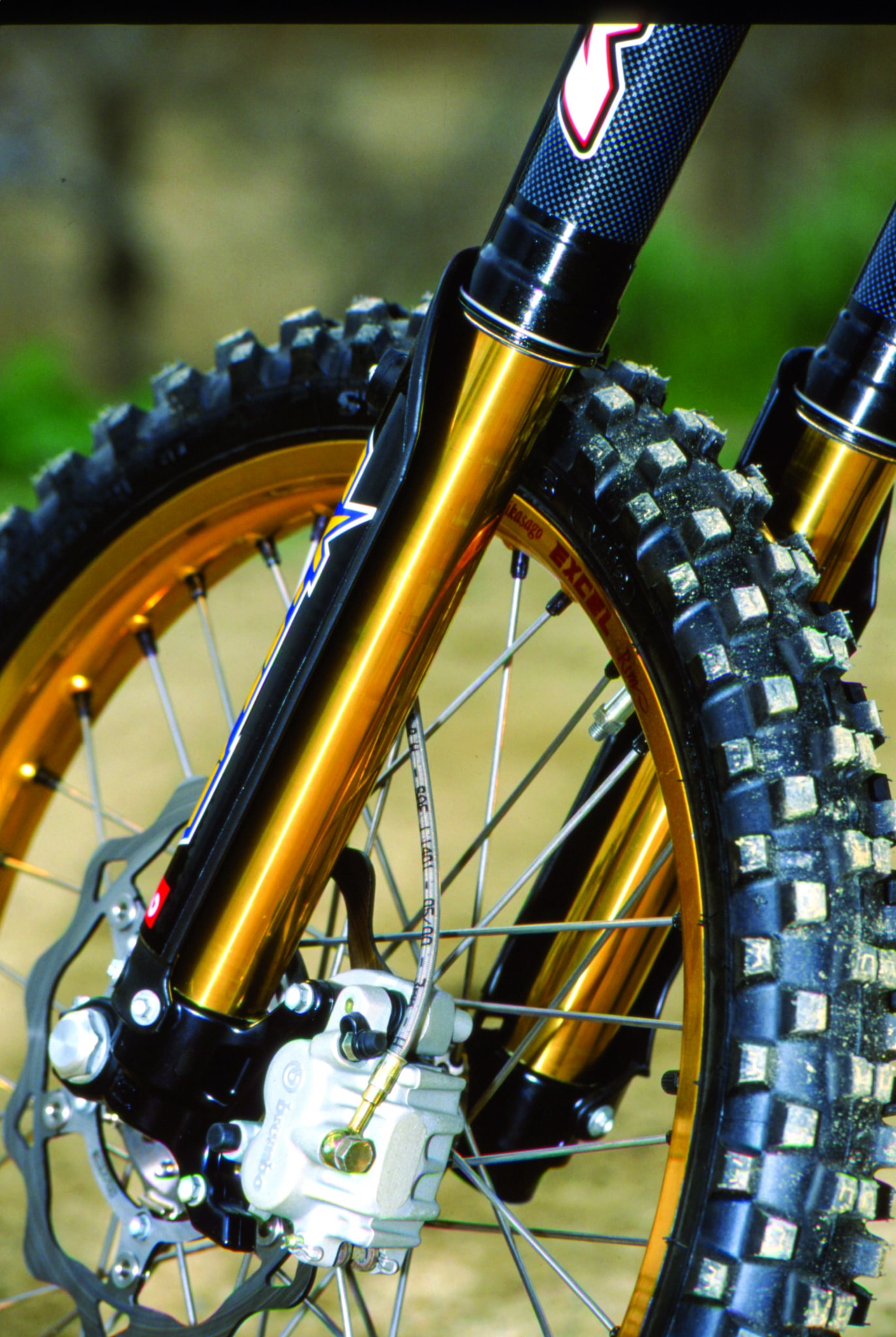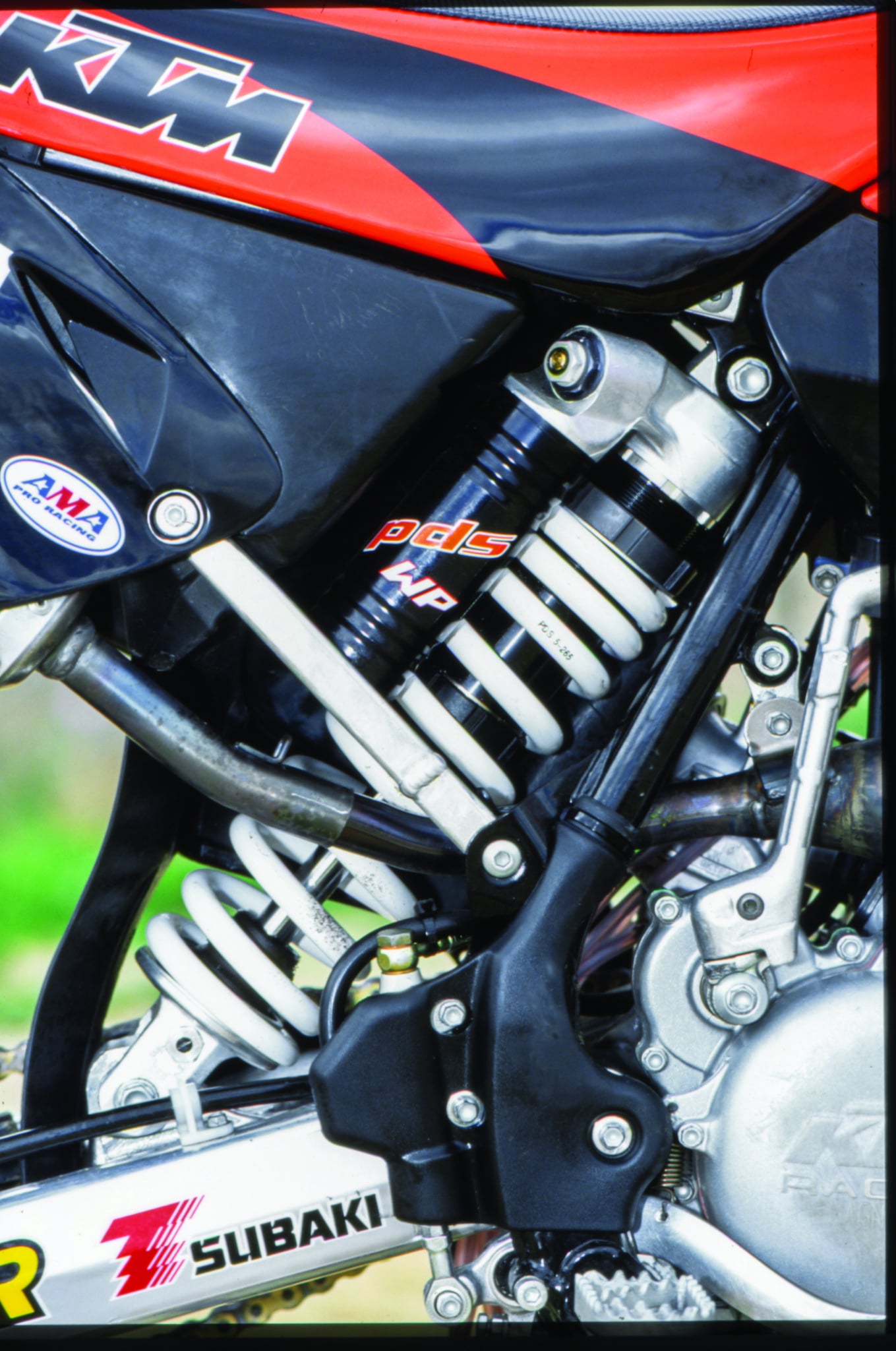MXA RETRO TEST: WE RIDE GRANT LANGSTON’S 2001 KTM 125SX

We get misty-eyed sometimes thinking about past bikes we loved and those that should remain forgotten. We take you on a trip down memory lane with bike tests that got filed away and disregarded in the MXA archives. We reminisce on a piece of moto history that has been resurrected. Here is our test of Grant Langton’s 2001 KTM 125SX.
Getting to test a works bike is both easy and hard. You might think that the factory teams wouldn’t want magazine test riders getting their sweaty palms all over their pride and joy, but you’d be wrong. Race teams know that their only reason for existing is to garner publicity for the production bikes. Getting publicity helps pay sponsors, enhance the reputation of the factory and get financing for next season. It’s a win/win situation.
On the other hand, there are people at every race team who don’t want magazine test riders to throw a leg over their bikes. More often than not, they are the riders and the mechanics. The riders don’t want you to ride their bikes for the same reason you don’t want them riding yours—they might ruin it. The mechanics don’t want you to ride the bike because they don’t want to waste a couple of days preparing the bike for a free joyride.
THE MXA WRECKING CREW UNDERSTANDS BOTH SIDES, SO WHEN WE ASKED TO TEST GRANT LANGSTON’S KTM 125, WE WERE PREPARED TO HEAR A NEGATIVE ANSWER BUT GLAD TO GET A RESOUNDING AFFIRMATIVE.
The MXA wrecking crew understands both sides (one year we almost destroyed Jeremy McGrath’s works Yamaha), so when we asked to test Grant Langston’s KTM 125, we were prepared to hear a negative answer but glad to get a resounding affirmative.
The reason we wanted to test Grant Langston’s bike is simple: Grant won the 125 World Championship in convincing fashion on a bike that everyone (who wasn’t on a KTM) said was unfair. No one believed that it was a cheater bike; they had just never seen a 125 go like that. MXA wanted to know if Langston’s production-based KTM 125SX was anywhere near as fast as his competition says it is.

THE REAL WORKS BIKE
Since full-on works bikes aren’t allowed in the USA, we love to hear stories of sand-cast cases, handmade swingarms and custom frames. And, Langston’s GP bike had all of these things. The cases were totally different from stock. The intake tract was straighter—and the KTM already had the straightest intake tract. The swingarm was special issue, and the frame was modified from race to race, depending on the conditions. The geometry could be changed to suit the track conditions. According to Grant’s mechanic, “After Grant won a few races, KTM started sending complete works bikes to us. On our dyno, we had 40 horsepower at the rear wheel. The funny thing is, KTM always claimed 42 horsepower at the rear wheel on its works bike, but every dyno is different.” Unfortunately for us, that was the bike Grant raced last year in Europe. We, on the other hand, were going to ride the Americanized version of that bike.

THE U.S. VERSION
So, what does Langston’s National bike have in common with his works bike from Europe? If you are only interested in the hardware, Langston didn’t get to bring much with him from Europe. The list is short: the pipe, silencer and transmission. To Grant’s credit, he said he didn’t care about the other stuff, just the engine. In fact, he brought over his engine man with him from Europe. There isn’t a single aspect of Langston’s engine that Harry Nolte hasn’t gone over with a fine-tooth comb.
Harry wasn’t the only thing that Langston brought directly over from Europe. To go with his European engine, Langston runs Doma pipes and silencers. Doma pipes are not readily available in the USA, but Langston’s father will be importing them.
Amazingly, KTM doesn’t run works ignitions in its race bikes. Instead, it spends lots of time working with FMF to get the perfect curve out of the over-the-counter FMF AOF ignition. As for Grant’s transmission choice, he runs taller first, second, third and fourth gears, leaving fifth and sixth alone.

THE TEST RIDE
We are embarrassed to tell you that while the MXA wrecking crew was hammering Langston’s bike, the KTM mechanics went to the side of the track and held up a pit board that said, “Shift.” Langston, it turns out, is not your typical 125 rider. Rather than revving the bike to the moon like most 125 pilots, Grant tries to use the transmission early and quickly. His power is all in the middle. When we went looking for low-end grunt or top-end shriek, we were sorely disappointed, which is strange considering that stock KTMs are famous for their willingness to rev.
If you think we were disappointed with Langston’s engine, you couldn’t be more wrong. We just had to adapt our riding style a bit (with some pit board help). Riding Langston’s bike to its potential requires you to think of it as a small 250. The speed secret is to keep shifting. Even if you don’t think it will pull the next gear, shift; it will.
The works transmission does help the midrange engine. With the taller gear ratios, each gear pulls a little further than the stock transmission. Another benefit of the works transmission is that it shifts better than the stocker; although, if you get the rpm up near the rev limiter, as we did, it doesn’t like to shift.

HOW THE CONTROLS WORK
Clutch: When will the rest of the factories wise up and go with hydraulic clutches? Langston used the stock Magura unit in Europe all last year without a hitch. The hydraulic unit makes no sacrifices when compared to the traditional cable-actuated clutch.
Brake: Langston’s front brake could be considered overwhelming. Using any more than one finger on the brake will result in an endo. Without a doubt, this is the strongest front brake we’ve ever tried—works or otherwise.
Bars: When KTM removed the Red Bull bar pad, we were sure that we wouldn’t see the stock Magura bars. We were wrong. Although Langston runs his bars very far forward, he does run the stock bars.
Grips: Langston is an animal. How do we know? He runs the stock Domino grips. They’ll last a lifetime, but a factory rider doesn’t really need bulletproof grips; he needs grips that are comfortable. The Domino grips aren’t all that comfortable.

WHAT ABOUT THAT WORKS SUSPENSION?
What a difference 5mm makes. KTM’s stock WP forks are only 43mm, and they aren’t all that good. KTM’s works forks are 48mm, and they work really well. The good news is that next year’s production KTM will come with the 48mm WP forks Langston’s bike has (although without the special coatings). The bad news is that unless you are Langston, you’ll have to wait a year.
The forks aren’t the only thing that makes the front of Langston’s bike better. Langston runs works KTM triple clamps with an 18mm offset (the stockers are 20mm). The 2mm difference moves the engine forward, which in turn puts more weight on the front of the bike. The added weight allows the bike to turn better, and, as far as we’re concerned, it also makes the suspension work better.

Langston’s works shock has high- and low-speed compression damping. And, like the forks, this shock will come stock on the 2002 models. Overall, Langston’s suspension was a tad stiff front and rear, but it was nothing that a fast rider couldn’t adjust to.

WHAT DO WE REALLY THINK?
Grant Langston has a strong personality. He isn’t wishy-washy. He knows exactly what he wants out of his bike. Grant swears that his Americanized bike is very close to his works bike. This is the combination that KTM, Grant and Harry Nolte plan to use to dominate the 125 Nationals. It could happen.








Comments are closed.